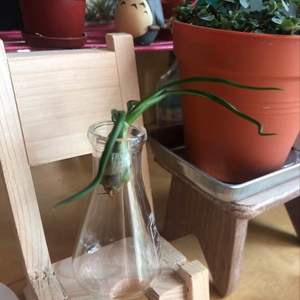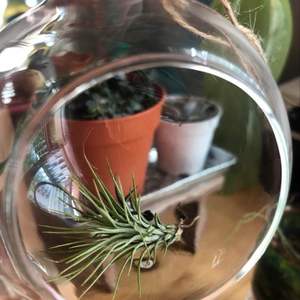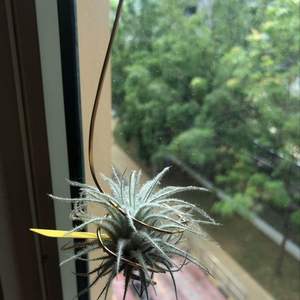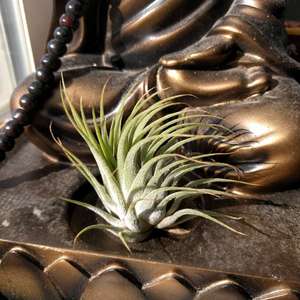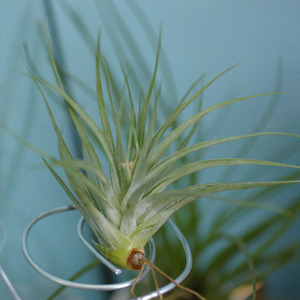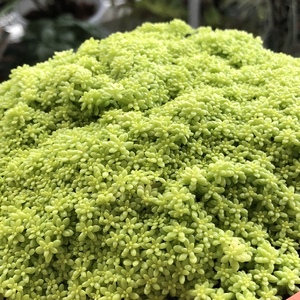文章
Miss Chen
2021年12月07日

If you are unfamiliar with Tillandsia or Tillys, as they are affectionately called by air plant aficionados, this article is going to introduce you to one of the genera’s most popular species.
Most plants of the genus are epiphytes, which means they grow on and take nutrients and moisture from other plants, rather than from the soil. Some plants in the genus do not even need another plant and can grow on constantly moving desert sand. This is definitely different from most people’s idea of how a plant grows. Most air plants are unique-looking and Tillandsia bulbosa is certainly a great example of this.
The bulbous air plant is an otherworldly looking species that features tendrils that appear from a prominent bulb at the base. This is, of course, where it gets both its botanical name and its common name.
The leaves of bulbousa are a dark green that turn a really lovely violet when the plant is ready to bloom. Don't expect a floral display every year, though, as it only flowers once in its lifetime. Once it blooms it then offsets pups and will clump or can be separated from the mother plant.
Air plants are normally easy to grow but bulbosa is especially easy as it has very relaxed watering needs. If you are interested in trying your hand at an air plant, this is the perfect starter option.
For people with a notoriously black thumb, who want to grow a plant in the worst way, air plants are the most sensible option, and Tillandsia bulbosa is really the best bet in succeeding with air plants.
Botanical Name Tillandsia bulbosa
Common Name Bulbous Air Plant
Plant Type perennial herbaceous
Mature Size 4–7 inches
Sun Exposure Bright, indirect light or part shade
Soil Type None
Soil pH None
Bloom Time Once per lifetime
Flower Color Violet
Hardiness Zones 9–11
Native Area Mexico, Central and South America
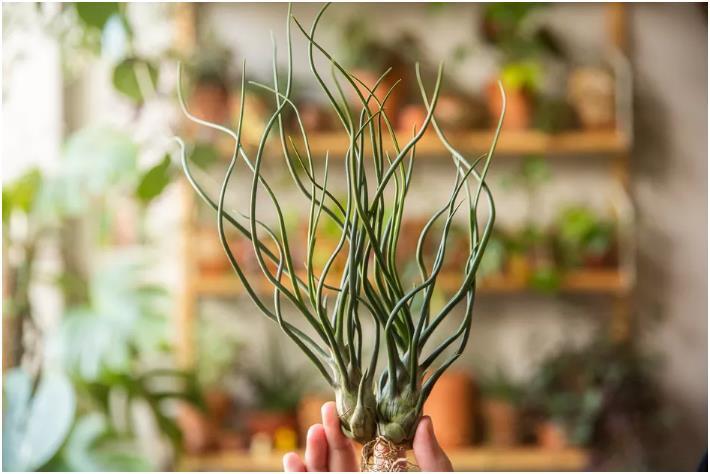
Tillandsia Bulbosa Care
Caring for Tillandsia bulbosa is extremely simple. Unlike most plants, the bulbosa will not need a container or soil. The vessel for displaying the air plant can be something as improvised as a found shell or a piece of driftwood. It can be suspended from a piece of wire or it can be placed in something as elaborate as a terrarium.
Light
Tillandsia bulbosa is very adaptable to light and partial shade. It does not particularly like bright sun and would prefer indirect light and partial shade, but it is a flexible plant.
Soil
Placing the plant in soil is actually going to harm it as it will cause moisture to remain in its hollow bulb and create the opportunity for rot.
Water
Watering a bulbosa is an easy task. Air plants differ from other plants in how they absorb water as they do not use their root system. Their roots are mainly used to secure them to other plants or rocks. Instead, along the leaves of tillandsias are tiny hair-like structures called trichomes and this is how they take in moisture.
The Bulbosa’s habitat is a relatively wet region so the leaves do not have an excess amount of trichomes, and they appear smooth. In air plants that live in drier climates, the number of trichomes will be profuse and give the air plants that famous silver or white look they are known for.
For bulbosa, it will usually only need two or three light mistings every week with a spray bottle. Try not to soak the leaves.
Temperature and Humidity
The Tillandsia bulbosa is native to the humid climates of South and Central America. It likes a moist environment and this can be achieved with regular, light mistings. The temperature is flexible as long as it remains above 55o Fahrenheit.
Fertilizer
Fertilizing is not necessary, but if you feel the need to fertilize seek out a specially formulated tillandsia variety.
Tillandsia Bulbosa Varieties
The wild type of Tillandsia bulbosa is really stunning and long-lasting. But one of the great things about the Bulbous air plant is the number of hybrids and cultivars that are commercially available. They offer a wide choice of colors, shapes and size while demanding no further care.
The cultivars range in size from Tillandsia bulbosa ‘Baby’, which is quite small, to the absolutely huge Tillandsia bulbosa ‘Gigante’.
Hybrids range from Tillandsia bulbosa x ionantha ‘Joel’ to Tillandsia Lucille x bulbosa ‘The Perfect Blend’ which change not only the form but color of the plant.
Propagating Tillandsia Bulbosa
It is also so easy to create new plants in this species. They put out offsets, called pups, at the base of the original plant. When these form to around half the size of the mother plant, you can easily remove them to mount them in a separate position.
Although bulbosa can be grown from seed it isn't an easy proposition and germination can take many months or even years.Light
Tillandsia bulbosa is very adaptable to light and partial shade. It does not particularly like bright sun and would prefer indirect light and partial shade, but it is a flexible plant.
Soil
Placing the plant in soil is actually going to harm it as it will cause moisture to remain in its hollow bulb and create the opportunity for rot.
Water
Watering a bulbosa is an easy task. Air plants differ from other plants in how they absorb water as they do not use their root system. Their roots are mainly used to secure them to other plants or rocks. Instead, along the leaves of tillandsias are tiny hair-like structures called trichomes and this is how they take in moisture.
The Bulbosa’s habitat is a relatively wet region so the leaves do not have an excess amount of trichomes, and they appear smooth. In air plants that live in drier climates, the number of trichomes will be profuse and give the air plants that famous silver or white look they are known for.
For bulbosa, it will usually only need two or three light mistings every week with a spray bottle. Try not to soak the leaves.
Temperature and Humidity
The Tillandsia bulbosa is native to the humid climates of South and Central America. It likes a moist environment and this can be achieved with regular, light mistings. The temperature is flexible as long as it remains above 55o Fahrenheit.
Fertilizer
Fertilizing is not necessary, but if you feel the need to fertilize seek out a specially formulated tillandsia variety.
Tillandsia Bulbosa Varieties
The wild type of Tillandsia bulbosa is really stunning and long-lasting. But one of the great things about the Bulbous air plant is the number of hybrids and cultivars that are commercially available. They offer a wide choice of colors, shapes and size while demanding no further care.
The cultivars range in size from Tillandsia bulbosa ‘Baby’, which is quite small, to the absolutely huge Tillandsia bulbosa ‘Gigante’.
Hybrids range from Tillandsia bulbosa x ionantha ‘Joel’ to Tillandsia Lucille x bulbosa ‘The Perfect Blend’ which change not only the form but color of the plant.
Propagating Tillandsia Bulbosa
It is also so easy to create new plants in this species. They put out offsets, called pups, at the base of the original plant. When these form to around half the size of the mother plant, you can easily remove them to mount them in a separate position.
Although bulbosa can be grown from seed it isn't an easy proposition and germination can take many months or even years.Light
Tillandsia bulbosa is very adaptable to light and partial shade. It does not particularly like bright sun and would prefer indirect light and partial shade, but it is a flexible plant.
Soil
Placing the plant in soil is actually going to harm it as it will cause moisture to remain in its hollow bulb and create the opportunity for rot.
Water
Watering a bulbosa is an easy task. Air plants differ from other plants in how they absorb water as they do not use their root system. Their roots are mainly used to secure them to other plants or rocks. Instead, along the leaves of tillandsias are tiny hair-like structures called trichomes and this is how they take in moisture.
The Bulbosa’s habitat is a relatively wet region so the leaves do not have an excess amount of trichomes, and they appear smooth. In air plants that live in drier climates, the number of trichomes will be profuse and give the air plants that famous silver or white look they are known for.
For bulbosa, it will usually only need two or three light mistings every week with a spray bottle. Try not to soak the leaves.
Temperature and Humidity
The Tillandsia bulbosa is native to the humid climates of South and Central America. It likes a moist environment and this can be achieved with regular, light mistings. The temperature is flexible as long as it remains above 55o Fahrenheit.
Fertilizer
Fertilizing is not necessary, but if you feel the need to fertilize seek out a specially formulated tillandsia variety.
Tillandsia Bulbosa Varieties
The wild type of Tillandsia bulbosa is really stunning and long-lasting. But one of the great things about the Bulbous air plant is the number of hybrids and cultivars that are commercially available. They offer a wide choice of colors, shapes and size while demanding no further care.
The cultivars range in size from Tillandsia bulbosa ‘Baby’, which is quite small, to the absolutely huge Tillandsia bulbosa ‘Gigante’.
Hybrids range from Tillandsia bulbosa x ionantha ‘Joel’ to Tillandsia Lucille x bulbosa ‘The Perfect Blend’ which change not only the form but color of the plant.
Propagating Tillandsia Bulbosa
It is also so easy to create new plants in this species. They put out offsets, called pups, at the base of the original plant. When these form to around half the size of the mother plant, you can easily remove them to mount them in a separate position.
Although bulbosa can be grown from seed it isn't an easy proposition and germination can take many months or even years.
Most plants of the genus are epiphytes, which means they grow on and take nutrients and moisture from other plants, rather than from the soil. Some plants in the genus do not even need another plant and can grow on constantly moving desert sand. This is definitely different from most people’s idea of how a plant grows. Most air plants are unique-looking and Tillandsia bulbosa is certainly a great example of this.
The bulbous air plant is an otherworldly looking species that features tendrils that appear from a prominent bulb at the base. This is, of course, where it gets both its botanical name and its common name.
The leaves of bulbousa are a dark green that turn a really lovely violet when the plant is ready to bloom. Don't expect a floral display every year, though, as it only flowers once in its lifetime. Once it blooms it then offsets pups and will clump or can be separated from the mother plant.
Air plants are normally easy to grow but bulbosa is especially easy as it has very relaxed watering needs. If you are interested in trying your hand at an air plant, this is the perfect starter option.
For people with a notoriously black thumb, who want to grow a plant in the worst way, air plants are the most sensible option, and Tillandsia bulbosa is really the best bet in succeeding with air plants.
Botanical Name Tillandsia bulbosa
Common Name Bulbous Air Plant
Plant Type perennial herbaceous
Mature Size 4–7 inches
Sun Exposure Bright, indirect light or part shade
Soil Type None
Soil pH None
Bloom Time Once per lifetime
Flower Color Violet
Hardiness Zones 9–11
Native Area Mexico, Central and South America

Tillandsia Bulbosa Care
Caring for Tillandsia bulbosa is extremely simple. Unlike most plants, the bulbosa will not need a container or soil. The vessel for displaying the air plant can be something as improvised as a found shell or a piece of driftwood. It can be suspended from a piece of wire or it can be placed in something as elaborate as a terrarium.
Light
Tillandsia bulbosa is very adaptable to light and partial shade. It does not particularly like bright sun and would prefer indirect light and partial shade, but it is a flexible plant.
Soil
Placing the plant in soil is actually going to harm it as it will cause moisture to remain in its hollow bulb and create the opportunity for rot.
Water
Watering a bulbosa is an easy task. Air plants differ from other plants in how they absorb water as they do not use their root system. Their roots are mainly used to secure them to other plants or rocks. Instead, along the leaves of tillandsias are tiny hair-like structures called trichomes and this is how they take in moisture.
The Bulbosa’s habitat is a relatively wet region so the leaves do not have an excess amount of trichomes, and they appear smooth. In air plants that live in drier climates, the number of trichomes will be profuse and give the air plants that famous silver or white look they are known for.
For bulbosa, it will usually only need two or three light mistings every week with a spray bottle. Try not to soak the leaves.
Temperature and Humidity
The Tillandsia bulbosa is native to the humid climates of South and Central America. It likes a moist environment and this can be achieved with regular, light mistings. The temperature is flexible as long as it remains above 55o Fahrenheit.
Fertilizer
Fertilizing is not necessary, but if you feel the need to fertilize seek out a specially formulated tillandsia variety.
Tillandsia Bulbosa Varieties
The wild type of Tillandsia bulbosa is really stunning and long-lasting. But one of the great things about the Bulbous air plant is the number of hybrids and cultivars that are commercially available. They offer a wide choice of colors, shapes and size while demanding no further care.
The cultivars range in size from Tillandsia bulbosa ‘Baby’, which is quite small, to the absolutely huge Tillandsia bulbosa ‘Gigante’.
Hybrids range from Tillandsia bulbosa x ionantha ‘Joel’ to Tillandsia Lucille x bulbosa ‘The Perfect Blend’ which change not only the form but color of the plant.
Propagating Tillandsia Bulbosa
It is also so easy to create new plants in this species. They put out offsets, called pups, at the base of the original plant. When these form to around half the size of the mother plant, you can easily remove them to mount them in a separate position.
Although bulbosa can be grown from seed it isn't an easy proposition and germination can take many months or even years.Light
Tillandsia bulbosa is very adaptable to light and partial shade. It does not particularly like bright sun and would prefer indirect light and partial shade, but it is a flexible plant.
Soil
Placing the plant in soil is actually going to harm it as it will cause moisture to remain in its hollow bulb and create the opportunity for rot.
Water
Watering a bulbosa is an easy task. Air plants differ from other plants in how they absorb water as they do not use their root system. Their roots are mainly used to secure them to other plants or rocks. Instead, along the leaves of tillandsias are tiny hair-like structures called trichomes and this is how they take in moisture.
The Bulbosa’s habitat is a relatively wet region so the leaves do not have an excess amount of trichomes, and they appear smooth. In air plants that live in drier climates, the number of trichomes will be profuse and give the air plants that famous silver or white look they are known for.
For bulbosa, it will usually only need two or three light mistings every week with a spray bottle. Try not to soak the leaves.
Temperature and Humidity
The Tillandsia bulbosa is native to the humid climates of South and Central America. It likes a moist environment and this can be achieved with regular, light mistings. The temperature is flexible as long as it remains above 55o Fahrenheit.
Fertilizer
Fertilizing is not necessary, but if you feel the need to fertilize seek out a specially formulated tillandsia variety.
Tillandsia Bulbosa Varieties
The wild type of Tillandsia bulbosa is really stunning and long-lasting. But one of the great things about the Bulbous air plant is the number of hybrids and cultivars that are commercially available. They offer a wide choice of colors, shapes and size while demanding no further care.
The cultivars range in size from Tillandsia bulbosa ‘Baby’, which is quite small, to the absolutely huge Tillandsia bulbosa ‘Gigante’.
Hybrids range from Tillandsia bulbosa x ionantha ‘Joel’ to Tillandsia Lucille x bulbosa ‘The Perfect Blend’ which change not only the form but color of the plant.
Propagating Tillandsia Bulbosa
It is also so easy to create new plants in this species. They put out offsets, called pups, at the base of the original plant. When these form to around half the size of the mother plant, you can easily remove them to mount them in a separate position.
Although bulbosa can be grown from seed it isn't an easy proposition and germination can take many months or even years.Light
Tillandsia bulbosa is very adaptable to light and partial shade. It does not particularly like bright sun and would prefer indirect light and partial shade, but it is a flexible plant.
Soil
Placing the plant in soil is actually going to harm it as it will cause moisture to remain in its hollow bulb and create the opportunity for rot.
Water
Watering a bulbosa is an easy task. Air plants differ from other plants in how they absorb water as they do not use their root system. Their roots are mainly used to secure them to other plants or rocks. Instead, along the leaves of tillandsias are tiny hair-like structures called trichomes and this is how they take in moisture.
The Bulbosa’s habitat is a relatively wet region so the leaves do not have an excess amount of trichomes, and they appear smooth. In air plants that live in drier climates, the number of trichomes will be profuse and give the air plants that famous silver or white look they are known for.
For bulbosa, it will usually only need two or three light mistings every week with a spray bottle. Try not to soak the leaves.
Temperature and Humidity
The Tillandsia bulbosa is native to the humid climates of South and Central America. It likes a moist environment and this can be achieved with regular, light mistings. The temperature is flexible as long as it remains above 55o Fahrenheit.
Fertilizer
Fertilizing is not necessary, but if you feel the need to fertilize seek out a specially formulated tillandsia variety.
Tillandsia Bulbosa Varieties
The wild type of Tillandsia bulbosa is really stunning and long-lasting. But one of the great things about the Bulbous air plant is the number of hybrids and cultivars that are commercially available. They offer a wide choice of colors, shapes and size while demanding no further care.
The cultivars range in size from Tillandsia bulbosa ‘Baby’, which is quite small, to the absolutely huge Tillandsia bulbosa ‘Gigante’.
Hybrids range from Tillandsia bulbosa x ionantha ‘Joel’ to Tillandsia Lucille x bulbosa ‘The Perfect Blend’ which change not only the form but color of the plant.
Propagating Tillandsia Bulbosa
It is also so easy to create new plants in this species. They put out offsets, called pups, at the base of the original plant. When these form to around half the size of the mother plant, you can easily remove them to mount them in a separate position.
Although bulbosa can be grown from seed it isn't an easy proposition and germination can take many months or even years.
0
0
文章
Miss Chen
2021年07月09日

Tillandsia stricta is a common species in the air plant family, but this doesn’t make them any less special. Their versatility makes them a popular choice, and their vibrant blooms make them a beautiful addition to your home.
This air plant comes in many different varieties, meaning there are a plethora of looks to choose from. Some varieties have soft leaves while others have hard. In addition to foliage structure, Tillandsia stricta plants also vary in color. Many are different tones of green, but there is also a variety with foliage so dark it is almost black.
Their flowers may be red, pink, blue, or purple. Interestingly, the actual flower only lasts one day when it blooms. However, the beautiful bracts that these flower sprout from will remain colorful and attractive for weeks.

Botanical Name Tillandsia stricta
Common Name Air plant
Plant Type Houseplant or annual
Mature Size 6 to 12 inches
Sun Exposure Bright, indirect light
Soil Type Not applicable
Soil pH Not applicable
Bloom Time Once, when fully matured
Flower Color Red, pink, blue, or purple
Hardiness Zones 9 to 11
Native Area South America
Tillandsia Stricta Care
The Tillandsia stricta is a hardy, low-maintenance specimen to add to your houseplant collection. They don't need soil and the key to their care if getting their watering and airflow right.
Eventually, your plant may reward you with its beautiful, vibrant blooms. This only happens when your plant reaches maturity, which may take years.
Occasionally, pests like mealybugs and scale may infect these plants.
Light
Most air plants thrive in bright, indirect light and the Tillandsia stricta is no exception. Place them in an area that receives bright sunlight from a window, but avoid positioning them directly on the windowsill. Too much direct sun can burn its foliage.
Soil
The fun thing about air plants is that they need air, not soil. Steer away from the temptation to place it in soil or moss just for looks. This can lead to rot and can kill your air plant.
Instead, embrace this soil-less plant and place it just about anywhere with good airflow. This could be sitting on a table or desk, hanging from the wall or ceiling, in a seashell, attached to a picture frame; the possibilities are endless.
If you would like to put it somewhere that needs a little extra support to keep it put, try fishing line, wire, or even a dab of glue. Just stay clear of copper or superglue, because these will kill your plant.
Water
Since your Tillandsia stricta has no soil to water, these plants need to go for a swim to get all the hydration they need. To do this, submerge your air plant in a bowl of clean water and let it soak it for 10 to 30 minutes.
If your Tillandsia stricta is sporting a flower at the time, be sure to keep the delicate flower out of the water to prevent damage. When finished soaking, remove your plant from the water and shake out any excess water hiding in the leaves. Check your plant after a couple of hours to ensure that it is completely dried off. If water sits too long in the leaves and core of the plant, it can cause rot.
Springwater, filtered water, or rainwater are best when watering your air plant. Steer away from tap water if you can, but if you must, be sure to let it sit for at least 24 hours before using it. This allows the chlorine commonly found in tap water to dissipate.
If you live in an area where you can grow Tillandsia stricta outside, placing it where it can receive natural rain is a great option. This will water your plant naturally and may eliminate the need to soak them as often.
Temperature and Humidity
Between these larger soaks, your Tillandsia stricta will thank you if you give it regular misting. This gives it the humidity and moisture it likes without overwhelming it or causing rot.
In hotter or drier climates, it would do good to mist your air plant every day. If you live in a more humid climate, you may only need to mist every three days or so.
As for temperature, most air plants do well in hot climates. However, they can handle anywhere from 50 to 90 degrees Fahrenheit just fine. Though they are hardy, keep your Tillandsia stricta away from AC or heating units. The intense heat or cold from these units can damage or kill your plant.
Fertilizer
Fertilizer can help create a healthy, happy air plant and may encourage blooming, growth, and pup production. However, your Tillandsia stricta does not require fertilizer and will grow just fine without any.
If given too much fertilizer, your plant can be burned or even die. If you would like to encourage more growth, fertilize once a month using a Bromeliad or Tillandsia fertilizer. These are designed to be absorbed through the leaves. Common fertilizer is meant to be absorbed through the roots of a plant, which is not how air plants receive their nutrients. Fertilizer is especially helpful when your Tillandsia stricta is blooming.

Propagating Tillandsia Stricta
Propagating your Tillandsia stricta is simple and an exciting way to take your plant cultivation hobby to the next level. When it is mature, your plant will produce pups at its base. These baby air plants are easily removed. Here is how:
1. Wait until your pup is at least a third of the size of the mother plant.
2. Identify where the pup is attached to the plant.
3. Carefully pop the pup off the mother plant with a gentle twist. To avoid damaging the new plant, grip the pup at the base and not from the top. If the pup does not easily pop off, a sharp knife or pair of snips may be needed to trim it from the mother.
4. Once the pup is detached, place in a well ventilated, bright spot of its own.
Air plants can take years to bloom and produce pups, so don’t get discouraged if you don’t see any. With proper care, your Tillandsia strict will reward you with bright blooms and pups in time.
This air plant comes in many different varieties, meaning there are a plethora of looks to choose from. Some varieties have soft leaves while others have hard. In addition to foliage structure, Tillandsia stricta plants also vary in color. Many are different tones of green, but there is also a variety with foliage so dark it is almost black.
Their flowers may be red, pink, blue, or purple. Interestingly, the actual flower only lasts one day when it blooms. However, the beautiful bracts that these flower sprout from will remain colorful and attractive for weeks.

Botanical Name Tillandsia stricta
Common Name Air plant
Plant Type Houseplant or annual
Mature Size 6 to 12 inches
Sun Exposure Bright, indirect light
Soil Type Not applicable
Soil pH Not applicable
Bloom Time Once, when fully matured
Flower Color Red, pink, blue, or purple
Hardiness Zones 9 to 11
Native Area South America
Tillandsia Stricta Care
The Tillandsia stricta is a hardy, low-maintenance specimen to add to your houseplant collection. They don't need soil and the key to their care if getting their watering and airflow right.
Eventually, your plant may reward you with its beautiful, vibrant blooms. This only happens when your plant reaches maturity, which may take years.
Occasionally, pests like mealybugs and scale may infect these plants.
Light
Most air plants thrive in bright, indirect light and the Tillandsia stricta is no exception. Place them in an area that receives bright sunlight from a window, but avoid positioning them directly on the windowsill. Too much direct sun can burn its foliage.
Soil
The fun thing about air plants is that they need air, not soil. Steer away from the temptation to place it in soil or moss just for looks. This can lead to rot and can kill your air plant.
Instead, embrace this soil-less plant and place it just about anywhere with good airflow. This could be sitting on a table or desk, hanging from the wall or ceiling, in a seashell, attached to a picture frame; the possibilities are endless.
If you would like to put it somewhere that needs a little extra support to keep it put, try fishing line, wire, or even a dab of glue. Just stay clear of copper or superglue, because these will kill your plant.
Water
Since your Tillandsia stricta has no soil to water, these plants need to go for a swim to get all the hydration they need. To do this, submerge your air plant in a bowl of clean water and let it soak it for 10 to 30 minutes.
If your Tillandsia stricta is sporting a flower at the time, be sure to keep the delicate flower out of the water to prevent damage. When finished soaking, remove your plant from the water and shake out any excess water hiding in the leaves. Check your plant after a couple of hours to ensure that it is completely dried off. If water sits too long in the leaves and core of the plant, it can cause rot.
Springwater, filtered water, or rainwater are best when watering your air plant. Steer away from tap water if you can, but if you must, be sure to let it sit for at least 24 hours before using it. This allows the chlorine commonly found in tap water to dissipate.
If you live in an area where you can grow Tillandsia stricta outside, placing it where it can receive natural rain is a great option. This will water your plant naturally and may eliminate the need to soak them as often.
Temperature and Humidity
Between these larger soaks, your Tillandsia stricta will thank you if you give it regular misting. This gives it the humidity and moisture it likes without overwhelming it or causing rot.
In hotter or drier climates, it would do good to mist your air plant every day. If you live in a more humid climate, you may only need to mist every three days or so.
As for temperature, most air plants do well in hot climates. However, they can handle anywhere from 50 to 90 degrees Fahrenheit just fine. Though they are hardy, keep your Tillandsia stricta away from AC or heating units. The intense heat or cold from these units can damage or kill your plant.
Fertilizer
Fertilizer can help create a healthy, happy air plant and may encourage blooming, growth, and pup production. However, your Tillandsia stricta does not require fertilizer and will grow just fine without any.
If given too much fertilizer, your plant can be burned or even die. If you would like to encourage more growth, fertilize once a month using a Bromeliad or Tillandsia fertilizer. These are designed to be absorbed through the leaves. Common fertilizer is meant to be absorbed through the roots of a plant, which is not how air plants receive their nutrients. Fertilizer is especially helpful when your Tillandsia stricta is blooming.

Propagating Tillandsia Stricta
Propagating your Tillandsia stricta is simple and an exciting way to take your plant cultivation hobby to the next level. When it is mature, your plant will produce pups at its base. These baby air plants are easily removed. Here is how:
1. Wait until your pup is at least a third of the size of the mother plant.
2. Identify where the pup is attached to the plant.
3. Carefully pop the pup off the mother plant with a gentle twist. To avoid damaging the new plant, grip the pup at the base and not from the top. If the pup does not easily pop off, a sharp knife or pair of snips may be needed to trim it from the mother.
4. Once the pup is detached, place in a well ventilated, bright spot of its own.
Air plants can take years to bloom and produce pups, so don’t get discouraged if you don’t see any. With proper care, your Tillandsia strict will reward you with bright blooms and pups in time.
0
0
文章
Miss Chen
2021年07月07日

No potting soil? No problem. You don’t need soil to keep your home full of gorgeous houseplants. Meet Tillandsia kolbii, a variety of air plant.
These plants actual absorb nutrients and water through their leaves, not their roots. Because of this, they don’t have big root systems like the usual houseplant. These plants can be set wherever you’d like a little greenery, no pot needed. In fact, you can even hang them.
The Tillandsia kolbii has compact, fuzzy leaves that are a soft green color. With proper care, they may also produce beautiful, unique blooms in red, orange, or purple.

Botanical Name Tillandsia kolbii
Common Name Air plant
Plant Type Houseplant or annual
Mature Size 1 to 3 inches
Sun Exposure Bright, indirect light
Soil Type Not applicable
Soil pH Not applicable
Bloom Time Once, when fully matured
Flower Color Red, orange, or purple
Hardiness Zones 9 to 11, USA
Native Area Mexico and Guatemala
Tillandsia Kolbii Care
Caring for these plants is a breeze. Choose an area with bright, indirect lighting and good airflow to keep your Tillandsia kolbii the happiest. The biggest thing they require is regular watering. How do you water a plant with no soil, you may ask? Regular misting is a wonderful way to keep your plants humid.
With proper attention and care, your Tillandsia kolbii may even bloom. These amazing little plants only bloom once in their lifetime, and the process may take years.
Once they are mature, they will produce pups. These are new little air plants that will pop out of the base of the mother plant. You can either leave these attached so they slowly grow a huge connected colony of air plants, or remove them to create more plants to spread around. Occasionally, mealybugs and scale may pose pest problems.
Light
Tillandsia kolbii, like most air plants, loves bright, indirect lighting. Despite being native to Mexico and Guatemala, too much sunshine can actually harm or burn the plant. Signs of too much sun include burn marks or red-tipped leaves. The red coloring is caused by stress.
Soil
The name “air plants” has become a popular way to describe plants belonging to the Tillandsia family because they don't need to be grown in soil.
Instead, just set your Tillandsia kolbii wherever you’d like to add a little greenery. Whether that be your desk, atop a decorative piece of driftwood, or even in a hanging terrarium. In warm areas, these plants can even be grown outside and make a wonderful addition to your porch décor.
Water
Unlike most houseplants, the Tillandsia kolbii cannot be watered in the usual fashion. To give your air plant the water it needs, soak it in a bowl of water for 10 to 30 minutes every week or two. If your air plant is blooming, be sure to keep the delicate flower above the water during a soak to avoid damaging it.
Once you remove your air plant from the water, tip it upside-down to let the excess water drain from its foliage, and then return it to its display area. Let your air plant dry completely before the next soaking session. This will help avoid problems with rot.
Make sure to use clean water, like spring or filtered water. If you must use tap water, let it sit for at least 24 hours to allow the chlorine to dissipate.
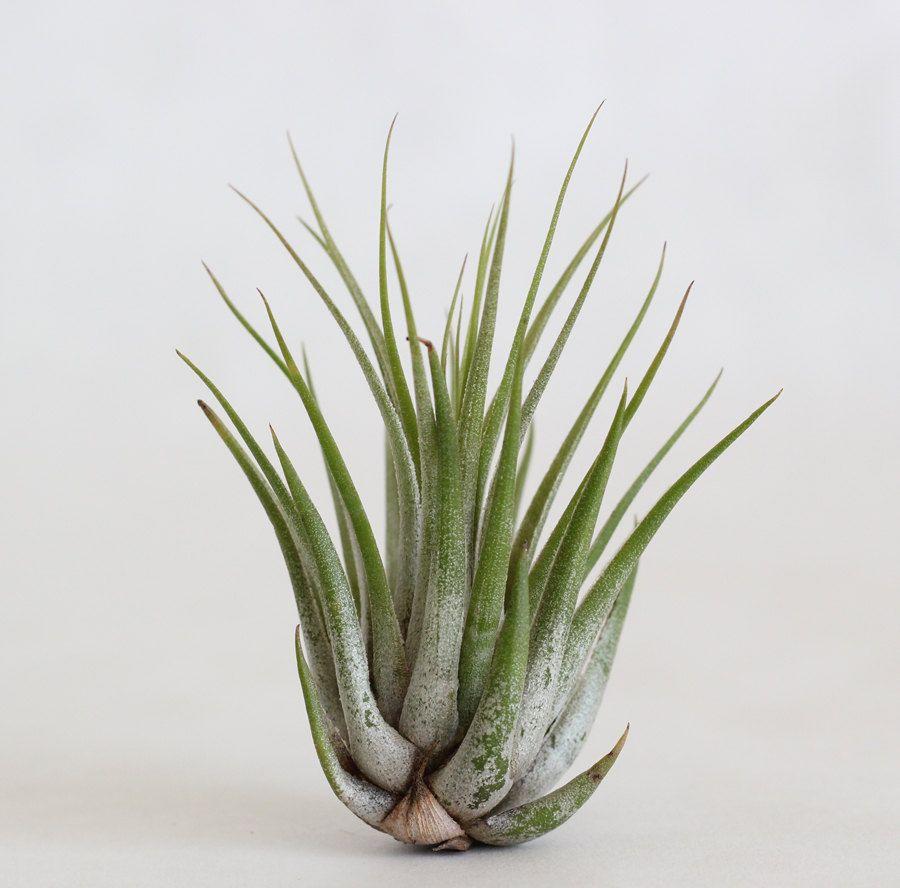
Temperature and Humidity
Tillandsia kolbii loves humidity. Regularly misting it will provide the humidity and moisture that it needs. In drier areas, you may need to mist your air plant daily. In more humid areas, you may only need to mist it every three days or so.
These plants also love warmer temperatures. However, avoid placing them near heating or AC units. Too much heat or cold can damage the plants. Placing them in a well-ventilated area with bright indirect sunlight is ideal.
Fertilizer
Because air plants do not have soil, you will need to fertilize during their monthly soak by adding it to the water. Using a fertilizer designed for air plants is best.
However, fertilizer is not a huge need for these little plants. They will grow wonderfully even without additional feeding. Too much fertilizer can even kill your Tillandsia kolbii.
Propagating Tillandsia kolbii
Propagating an air plant is fun and easy. In fact, your air plant will tell you when. These plants create what are known as “pups” once they are mature. These pups are new air plants. Once your Tillandsia kolbii is mature and producing pups, here is how to remove them.
1. Wait until your pup is at least a third of the size of the mother plant.
2. Locate the base of the pup.
3. Gently pop the pup off the mother plant. Be sure to grip the pup at its base leaves so no tearing occurs on its top leaves. If the pup does not easily pop off, a sharp knife or pair of snips may be needed to trim the pup from the mother.
4. Once the pup is detached, place it in a well ventilated, bright spot of its own.
Before you know it, you’ll have a whole family of air plants. Don’t be discouraged if you do not see pups for some time, though. Air plants can take years to bloom and produce pups. Patience is key.
These plants actual absorb nutrients and water through their leaves, not their roots. Because of this, they don’t have big root systems like the usual houseplant. These plants can be set wherever you’d like a little greenery, no pot needed. In fact, you can even hang them.
The Tillandsia kolbii has compact, fuzzy leaves that are a soft green color. With proper care, they may also produce beautiful, unique blooms in red, orange, or purple.

Botanical Name Tillandsia kolbii
Common Name Air plant
Plant Type Houseplant or annual
Mature Size 1 to 3 inches
Sun Exposure Bright, indirect light
Soil Type Not applicable
Soil pH Not applicable
Bloom Time Once, when fully matured
Flower Color Red, orange, or purple
Hardiness Zones 9 to 11, USA
Native Area Mexico and Guatemala
Tillandsia Kolbii Care
Caring for these plants is a breeze. Choose an area with bright, indirect lighting and good airflow to keep your Tillandsia kolbii the happiest. The biggest thing they require is regular watering. How do you water a plant with no soil, you may ask? Regular misting is a wonderful way to keep your plants humid.
With proper attention and care, your Tillandsia kolbii may even bloom. These amazing little plants only bloom once in their lifetime, and the process may take years.
Once they are mature, they will produce pups. These are new little air plants that will pop out of the base of the mother plant. You can either leave these attached so they slowly grow a huge connected colony of air plants, or remove them to create more plants to spread around. Occasionally, mealybugs and scale may pose pest problems.
Light
Tillandsia kolbii, like most air plants, loves bright, indirect lighting. Despite being native to Mexico and Guatemala, too much sunshine can actually harm or burn the plant. Signs of too much sun include burn marks or red-tipped leaves. The red coloring is caused by stress.
Soil
The name “air plants” has become a popular way to describe plants belonging to the Tillandsia family because they don't need to be grown in soil.
Instead, just set your Tillandsia kolbii wherever you’d like to add a little greenery. Whether that be your desk, atop a decorative piece of driftwood, or even in a hanging terrarium. In warm areas, these plants can even be grown outside and make a wonderful addition to your porch décor.
Water
Unlike most houseplants, the Tillandsia kolbii cannot be watered in the usual fashion. To give your air plant the water it needs, soak it in a bowl of water for 10 to 30 minutes every week or two. If your air plant is blooming, be sure to keep the delicate flower above the water during a soak to avoid damaging it.
Once you remove your air plant from the water, tip it upside-down to let the excess water drain from its foliage, and then return it to its display area. Let your air plant dry completely before the next soaking session. This will help avoid problems with rot.
Make sure to use clean water, like spring or filtered water. If you must use tap water, let it sit for at least 24 hours to allow the chlorine to dissipate.

Temperature and Humidity
Tillandsia kolbii loves humidity. Regularly misting it will provide the humidity and moisture that it needs. In drier areas, you may need to mist your air plant daily. In more humid areas, you may only need to mist it every three days or so.
These plants also love warmer temperatures. However, avoid placing them near heating or AC units. Too much heat or cold can damage the plants. Placing them in a well-ventilated area with bright indirect sunlight is ideal.
Fertilizer
Because air plants do not have soil, you will need to fertilize during their monthly soak by adding it to the water. Using a fertilizer designed for air plants is best.
However, fertilizer is not a huge need for these little plants. They will grow wonderfully even without additional feeding. Too much fertilizer can even kill your Tillandsia kolbii.
Propagating Tillandsia kolbii
Propagating an air plant is fun and easy. In fact, your air plant will tell you when. These plants create what are known as “pups” once they are mature. These pups are new air plants. Once your Tillandsia kolbii is mature and producing pups, here is how to remove them.
1. Wait until your pup is at least a third of the size of the mother plant.
2. Locate the base of the pup.
3. Gently pop the pup off the mother plant. Be sure to grip the pup at its base leaves so no tearing occurs on its top leaves. If the pup does not easily pop off, a sharp knife or pair of snips may be needed to trim the pup from the mother.
4. Once the pup is detached, place it in a well ventilated, bright spot of its own.
Before you know it, you’ll have a whole family of air plants. Don’t be discouraged if you do not see pups for some time, though. Air plants can take years to bloom and produce pups. Patience is key.
0
0
文章
Miss Chen
2021年07月03日

Looking for an air plant to really make a statement? The Tillandsia cacticola may just be the perfect, eye-catching addition. This tillandsia species is rare and only found in the high altitudes of Peru. They can be seen clinging to rocks or cacti, and are distinguished by their light, sage green foliage.
These air plants are covered in tiny hairs, making their leaves soft in texture. The Tillandsia cacticola grows upwards along a tall stem, sending its sprawling foliage outward to make a wild, beautiful display.
When these air plants bloom, they create tall white or lavender blooms sure to stand out among your plants. These blooms are long-lasting and may stick around for months on end.
Botanical Name Tillandsia cacticola
Common Name Air plant
Plant Type Houseplant or annual
Mature Size 6 inches tall and 6 to 18 inches wide
Sun Exposure Bright, indirect light to full sun
Soil Type Not applicable
Soil pH Not applicable
Bloom Time Once, when fully matured
Flower Color White or lavender
Hardiness Zones 9 to 11
Native Area Peru
Tillandsia Cacticola Care
The Tillandsia cacticola makes an easy and unique addition to almost any area of your home, inside or out. Since the Tillandsia cacticola is an air plant, it needs no soil and can be placed in a variety of locations. An area with bright, indirect lighting and good airflow would make the perfect place for your air plant.
Though intimidating at first, caring for these soil-less plants is actually very easy. The biggest thing they require is regular watering.
With patience and care, your Tillandsia cacticola can even bloom. This process may take years to achieve, but their one-time display is worth the wait.
Once these plants are mature, they will produce pups or new air plants. Once these appear, you can gently remove them to create more air plants. Removing them is not necessary, though. You can also leave them attached and slowly grow one large clump of air plants.
Common pests include mealybugs and scale.
Light
Tillandsia cacticola love bright, indirect lighting. This variety can tolerate and enjoy even more direct sunshine than most air plants. This is due to its many tiny hairs, or trichomes, on its foliage.
Soil
Air plants need no soil at all. In fact, they require good airflow. Placing their base in soil or moss will restrict airflow and keep them too moist.
Since no pot is needed, you can set your Tillandsia cacticola wherever you’d like to add a little greenery. Placing them in seashells, a decorative piece of wood, or in hanging terrariums all make wonderful options.
Water
The Tillandsia cacticola is more drought-resistant than other air plants. Even so, these plants still need a good soak every week. A good indicator to look for is curling leaves. This is a sign that your Tillandsia cacticola needs a drink.
When this occurs, submerge your plant in a bowl of water and leave it for 10 to 30 minutes. If your plant is in bloom, keep the delicate flower above the water to prevent damage.
Once your air plant is done soaking remove from the water and shake out any excess water pooling in the leaves. Be sure that your air plant dries completely in a couple of hours to prevent rot. Also, ensure that your water is clean when soaking your Tillandsia cacticola. Springwater, filtered water, or rainwater are best. If you have to use tap water, let it sit for at least 24 hours to reduce chlorine levels.
If you are growing this plant outside, placing it in an area where it will receive natural rain may eliminate the need to soak as often.
Temperature and Humidity
Tillandsia cacticola, although being more drought resistant, still loves a healthy dose of humidity. A regular schedule of misting will give it the additional moisture that it needs. If your Tillandsia cacticola is in a very dry, hot climate you may need to mist daily. In humid environments, every four to five days will do.
These plants do well in hot climates. However, if kept inside, avoid placing them near heating or AC units. The intense heat or cold from these units can damage the plants. Your Tillandsia cacticola will appreciate being in an area with good airflow and ventilation.
Fertilizer
Regular fertilizing is not necessary for your Tillandsia cacticola to survive. In fact, too much fertilizer can burn and kill air plants. However, the proper fertilizer given in the right amounts can contribute to a healthy, happy plant and may encourage blooming, growth, and pup production.
Be sure to use a Bromeliad or Tillandsia fertilizer since these are designed to be absorbed through the leaves. Common fertilizer is meant to be absorbed from the soil through the plant’s roots, which is not how air plants receive their nutrients. Fertilize once a month for the best results, especially if you see your Tillandsia cacticola beginning to bloom.
Propagating Tillandsia Cacticola
Propagating Tillandsia cacticola is simple. However, this variety of air plants is not as prolific as others, so you may only see one or two pups once it is mature. Once you see these pups, you can easily remove them to create more air plants. Here is how:
1. When the pup is at least a third the size of the parent plant, it is mature enough to separate.
2. Identify the pup's base, where it is attached to the parent plant.
3. Gently separate the pup off the parent plant. Aim to pull the pup from its base leaves so you don't damage the top leaves. You may need to use a sharp knife or scissors if the pup doesn't easily detach.
4. Once the pup is separated, place in a well ventilated, bright spot of its own.
Keep in mind that air plants can take years to bloom and produce pups, so you may need to cultivate Tillandisa cacticola for some time before propagation.
These air plants are covered in tiny hairs, making their leaves soft in texture. The Tillandsia cacticola grows upwards along a tall stem, sending its sprawling foliage outward to make a wild, beautiful display.
When these air plants bloom, they create tall white or lavender blooms sure to stand out among your plants. These blooms are long-lasting and may stick around for months on end.
Botanical Name Tillandsia cacticola
Common Name Air plant
Plant Type Houseplant or annual
Mature Size 6 inches tall and 6 to 18 inches wide
Sun Exposure Bright, indirect light to full sun
Soil Type Not applicable
Soil pH Not applicable
Bloom Time Once, when fully matured
Flower Color White or lavender
Hardiness Zones 9 to 11
Native Area Peru
Tillandsia Cacticola Care
The Tillandsia cacticola makes an easy and unique addition to almost any area of your home, inside or out. Since the Tillandsia cacticola is an air plant, it needs no soil and can be placed in a variety of locations. An area with bright, indirect lighting and good airflow would make the perfect place for your air plant.
Though intimidating at first, caring for these soil-less plants is actually very easy. The biggest thing they require is regular watering.
With patience and care, your Tillandsia cacticola can even bloom. This process may take years to achieve, but their one-time display is worth the wait.
Once these plants are mature, they will produce pups or new air plants. Once these appear, you can gently remove them to create more air plants. Removing them is not necessary, though. You can also leave them attached and slowly grow one large clump of air plants.
Common pests include mealybugs and scale.
Light
Tillandsia cacticola love bright, indirect lighting. This variety can tolerate and enjoy even more direct sunshine than most air plants. This is due to its many tiny hairs, or trichomes, on its foliage.
Soil
Air plants need no soil at all. In fact, they require good airflow. Placing their base in soil or moss will restrict airflow and keep them too moist.
Since no pot is needed, you can set your Tillandsia cacticola wherever you’d like to add a little greenery. Placing them in seashells, a decorative piece of wood, or in hanging terrariums all make wonderful options.
Water
The Tillandsia cacticola is more drought-resistant than other air plants. Even so, these plants still need a good soak every week. A good indicator to look for is curling leaves. This is a sign that your Tillandsia cacticola needs a drink.
When this occurs, submerge your plant in a bowl of water and leave it for 10 to 30 minutes. If your plant is in bloom, keep the delicate flower above the water to prevent damage.
Once your air plant is done soaking remove from the water and shake out any excess water pooling in the leaves. Be sure that your air plant dries completely in a couple of hours to prevent rot. Also, ensure that your water is clean when soaking your Tillandsia cacticola. Springwater, filtered water, or rainwater are best. If you have to use tap water, let it sit for at least 24 hours to reduce chlorine levels.
If you are growing this plant outside, placing it in an area where it will receive natural rain may eliminate the need to soak as often.
Temperature and Humidity
Tillandsia cacticola, although being more drought resistant, still loves a healthy dose of humidity. A regular schedule of misting will give it the additional moisture that it needs. If your Tillandsia cacticola is in a very dry, hot climate you may need to mist daily. In humid environments, every four to five days will do.
These plants do well in hot climates. However, if kept inside, avoid placing them near heating or AC units. The intense heat or cold from these units can damage the plants. Your Tillandsia cacticola will appreciate being in an area with good airflow and ventilation.
Fertilizer
Regular fertilizing is not necessary for your Tillandsia cacticola to survive. In fact, too much fertilizer can burn and kill air plants. However, the proper fertilizer given in the right amounts can contribute to a healthy, happy plant and may encourage blooming, growth, and pup production.
Be sure to use a Bromeliad or Tillandsia fertilizer since these are designed to be absorbed through the leaves. Common fertilizer is meant to be absorbed from the soil through the plant’s roots, which is not how air plants receive their nutrients. Fertilize once a month for the best results, especially if you see your Tillandsia cacticola beginning to bloom.
Propagating Tillandsia Cacticola
Propagating Tillandsia cacticola is simple. However, this variety of air plants is not as prolific as others, so you may only see one or two pups once it is mature. Once you see these pups, you can easily remove them to create more air plants. Here is how:
1. When the pup is at least a third the size of the parent plant, it is mature enough to separate.
2. Identify the pup's base, where it is attached to the parent plant.
3. Gently separate the pup off the parent plant. Aim to pull the pup from its base leaves so you don't damage the top leaves. You may need to use a sharp knife or scissors if the pup doesn't easily detach.
4. Once the pup is separated, place in a well ventilated, bright spot of its own.
Keep in mind that air plants can take years to bloom and produce pups, so you may need to cultivate Tillandisa cacticola for some time before propagation.
0
0
成长记
Prince Bill
2019年03月12日

I now added "Tillandsia" in my "garden"


0
0
Sandra66:I loved these plants but never had much luck with them. I would have for awhile even had one flower then it died 😞







